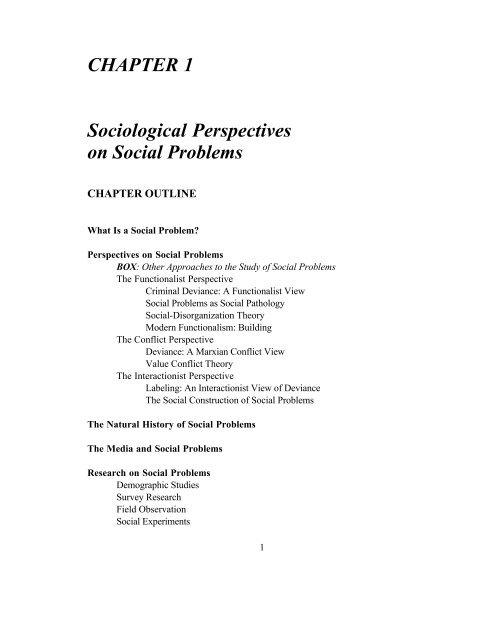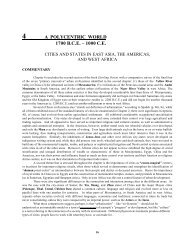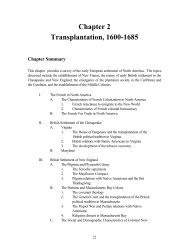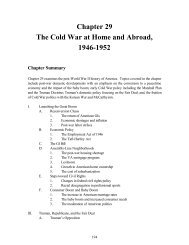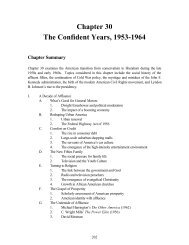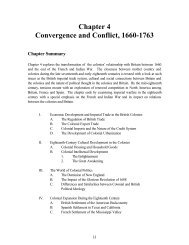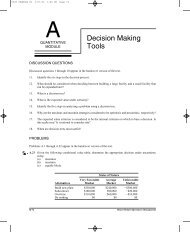CHAPTER 1 Sociological Perspectives on Social Problems
CHAPTER 1 Sociological Perspectives on Social Problems
CHAPTER 1 Sociological Perspectives on Social Problems
You also want an ePaper? Increase the reach of your titles
YUMPU automatically turns print PDFs into web optimized ePapers that Google loves.
<str<strong>on</strong>g>CHAPTER</str<strong>on</strong>g> 1<br />
<str<strong>on</strong>g>Sociological</str<strong>on</strong>g> <str<strong>on</strong>g>Perspectives</str<strong>on</strong>g><br />
<strong>on</strong> <strong>Social</strong> <strong>Problems</strong><br />
<str<strong>on</strong>g>CHAPTER</str<strong>on</strong>g> OUTLINE<br />
What Is a <strong>Social</strong> Problem?<br />
<str<strong>on</strong>g>Perspectives</str<strong>on</strong>g> <strong>on</strong> <strong>Social</strong> <strong>Problems</strong><br />
BOX: Other Approaches to the Study of <strong>Social</strong> <strong>Problems</strong><br />
The Functi<strong>on</strong>alist Perspective<br />
Criminal Deviance: A Functi<strong>on</strong>alist View<br />
<strong>Social</strong> <strong>Problems</strong> as <strong>Social</strong> Pathology<br />
<strong>Social</strong>-Disorganizati<strong>on</strong> Theory<br />
Modern Functi<strong>on</strong>alism: Building<br />
The C<strong>on</strong>flict Perspective<br />
Deviance: A Marxian C<strong>on</strong>flict View<br />
Value C<strong>on</strong>flict Theory<br />
The Interacti<strong>on</strong>ist Perspective<br />
Labeling: An Interacti<strong>on</strong>ist View of Deviance<br />
The <strong>Social</strong> C<strong>on</strong>structi<strong>on</strong> of <strong>Social</strong> <strong>Problems</strong><br />
The Natural History of <strong>Social</strong> <strong>Problems</strong><br />
The Media and <strong>Social</strong> <strong>Problems</strong><br />
Research <strong>on</strong> <strong>Social</strong> <strong>Problems</strong><br />
Demographic Studies<br />
Survey Research<br />
Field Observati<strong>on</strong><br />
<strong>Social</strong> Experiments<br />
1
BOX: SOCIAL PROBLEMS ONLINE: "Researching <strong>Social</strong> <strong>Problems</strong>"<br />
<strong>Social</strong> Policy<br />
Bey<strong>on</strong>d Left and Right<br />
<str<strong>on</strong>g>CHAPTER</str<strong>on</strong>g> OVERVIEW<br />
The chapter begins with a sociological definiti<strong>on</strong> of social problems and follows<br />
with a detailed discussi<strong>on</strong> of the comp<strong>on</strong>ents of that definiti<strong>on</strong>.<br />
There are three major sociological perspectives <strong>on</strong> social problems: functi<strong>on</strong>alism,<br />
c<strong>on</strong>flict theory, and interacti<strong>on</strong>ism. Treatment of the functi<strong>on</strong>alist perspective includes a<br />
vignette of criminal deviance from this point of view; the functi<strong>on</strong>alist orientati<strong>on</strong> toward<br />
social problems as social pathology (including social disorganizati<strong>on</strong> theory); and a<br />
discussi<strong>on</strong> of modern functi<strong>on</strong>alism (instituti<strong>on</strong> building). The text's assessment of the<br />
c<strong>on</strong>flict perspective includes a detailed look at the work of Karl Marx, a vignette of<br />
deviance from this point of view, and an assessment of value c<strong>on</strong>flict theory. The<br />
discussi<strong>on</strong> of interacti<strong>on</strong>ism focuses <strong>on</strong> labeling theory and its applicati<strong>on</strong> to social<br />
problems, including the distincti<strong>on</strong> between primary and sec<strong>on</strong>dary deviance.<br />
The “natural history” approach to social problems details the four major stages<br />
that most social problems seem to go through: problem definiti<strong>on</strong>, legitimacy, reemergence<br />
of demands, and rejecti<strong>on</strong>/instituti<strong>on</strong> building.<br />
There is an important relati<strong>on</strong>ship between the media and social problems,<br />
particularly in view of the communicati<strong>on</strong>s revoluti<strong>on</strong> that took place in the sec<strong>on</strong>d half<br />
of the twentieth century.<br />
A secti<strong>on</strong> <strong>on</strong> research c<strong>on</strong>cerning social problems includes illustrati<strong>on</strong>s based up<strong>on</strong><br />
classic sociological investigati<strong>on</strong>s by Katherine Newman and William Julius Wils<strong>on</strong>, Lyn<br />
Lofland, and Kai Eriks<strong>on</strong>. The major types of research <strong>on</strong> social problems are discussed:<br />
demographic studies, survey research, field observati<strong>on</strong>, and social experiments.<br />
The chapter c<strong>on</strong>cludes with a secti<strong>on</strong> <strong>on</strong> social problems and social policy. <strong>Social</strong><br />
policy involves formal procedures designed to remedy a social problem. C<strong>on</strong>servative<br />
and liberal views are compared.<br />
2
TEACHING OBJECTIVES<br />
STUDENTS SHOULD:<br />
1. be able to define a social problem and be familiar with the key comp<strong>on</strong>ents of this<br />
definiti<strong>on</strong>.<br />
2. be familiar with the three sociological perspectives <strong>on</strong> social problems:<br />
functi<strong>on</strong>alism, c<strong>on</strong>flict theory, and interacti<strong>on</strong>ism; including the following<br />
elements: the functi<strong>on</strong>alist view of criminal deviance, social problems as social<br />
pathology, social disorganizati<strong>on</strong> theory, modern functi<strong>on</strong>alism, the Marxian view<br />
of deviance, value c<strong>on</strong>flict theory, and labeling theory.<br />
3. understand the “natural history” of social problems and be familiar with the stages<br />
that most social problems seem to go through.<br />
4. be familiar with the relati<strong>on</strong>ship between the media and social problems.<br />
5. understand the major research strategies <strong>on</strong> social problems: demographic studies,<br />
survey research, field observati<strong>on</strong>, and social experiments.<br />
6. understand the c<strong>on</strong>cept of social policy and how policy issues impact <strong>on</strong> the<br />
sociological investigati<strong>on</strong> of social problems.<br />
TEACHING SUGGESTIONS, DISCUSSION QUESTIONS,<br />
AND CLASS EXERCISES<br />
1. Many students who enroll in the <strong>Social</strong> <strong>Problems</strong> course will have difficulty<br />
seeing the interc<strong>on</strong>nectedness of the problematic issues under study--they will<br />
tend to view each problem as a separate issue to be solved independently from the<br />
others. The theoretical perspectives can be used to advantage here. Encourage<br />
students to think about why we need more than <strong>on</strong>e theoretical approach in<br />
studying social problems--why can't there be just <strong>on</strong>e perspective that will cover<br />
all bases? Through this discussi<strong>on</strong>, students will develop an appreciati<strong>on</strong> for the<br />
complexity of social problems and understand why divergent perspectives are<br />
required in order to analyze so many different issues. Another way to deal with<br />
this is through presentati<strong>on</strong> of the excellent material in an article by Georganne<br />
4
Rundblad, “Addressing <strong>Social</strong> <strong>Problems</strong>, Focusing <strong>on</strong> Soluti<strong>on</strong>s: The Community<br />
Explorati<strong>on</strong> Project” (Teaching Sociology 26, October, 1998: 330-340).<br />
2. In his article “Unc<strong>on</strong>venti<strong>on</strong>al First Days: Encouraging Students to W<strong>on</strong>der About<br />
<strong>Social</strong> Life and Learning” (Teaching Sociology, 27, July, 1999: 258-263), Paul<br />
Higgens points out that the first day of a college course is very important and can<br />
set the t<strong>on</strong>e for the balance of the semester. You may find Higgens’s article<br />
helpful as you c<strong>on</strong>struct your pers<strong>on</strong>al approach to the social problems course.<br />
3. The text includes a number of special features that are related to the Internet and<br />
World Wide Web. Theodore D. Fuller offers c<strong>on</strong>siderable insight about the use of<br />
computers in the social problems course (“Using Computer Assignments to<br />
Promote Active Learning in the Undergraduate <strong>Social</strong> <strong>Problems</strong> Course,” Teaching<br />
Sociology, 26, July, 1998: 215-221). If you plan to utilize computer support in<br />
your own class, Fuller’s article may be helpful.<br />
4. In many ways, the problems involved with teaching sociological theory are similar<br />
to those encountered by instructors who teach methodology. Students frequently<br />
comment that theory and methods are "boring" and "not very useful." And,<br />
undergraduate students are frequently intimidated by these discussi<strong>on</strong>s because<br />
they are largely unfamiliar with theory and methods. Kathleen S. Lowney offers<br />
an exercise that should help your students in her article, “Reducing ‘Theory<br />
Anxiety’ Through Puzzles” (Teaching Sociology, 26, January, 1998: 69-73).<br />
4. William T. Markham ("Research Methods in the Introductory Course: To Be or<br />
Not to Be?" Teaching Sociology 19, October, 1991: 464-471) observes that introductory<br />
sociology courses usually fail to provide adequate informati<strong>on</strong> about<br />
gathering, interpreting, presenting, or evaluating data. Markham points out that<br />
this situati<strong>on</strong> is good for neither students or society. In his article, Markham<br />
presents a comprehensive strategy for integrating methodological issues into<br />
discussi<strong>on</strong>s of substantive topics in sociology and social problems. He also<br />
discusses techniques for minimizing students' resistance to learning about research<br />
methods.<br />
5. In c<strong>on</strong>juncti<strong>on</strong> with the interacti<strong>on</strong>ist perspective, the c<strong>on</strong>cepts of ethnocentrism<br />
and cultural relativity are essential for understanding social problems. Kim<br />
Schopmeyer and Bradley Fisher present some interesting instructi<strong>on</strong>al techniques<br />
for exploring ethnocentrism and cultural relativity in their article, "Insiders and<br />
Outsiders: Exploring Ethnocentrism and Cultural Relativity in Sociology Courses"<br />
(Teaching Sociology, 21, April, 1993: 148-153).<br />
6. Have your students put their increased knowledge of dealing with social problems<br />
5
into practice by focusing <strong>on</strong> the university community: What c<strong>on</strong>diti<strong>on</strong>s do they<br />
c<strong>on</strong>sider to be social problems <strong>on</strong> campus? Develop the following scenario with<br />
your students: You are the chairpers<strong>on</strong> of a student governing body <strong>on</strong> campus<br />
with a budget of $20,000 for the soluti<strong>on</strong> of university-related problems. The<br />
budget is obviously limited and will be inadequate to address all of the campus's<br />
problems. Which problems will you select for soluti<strong>on</strong> and why? Then, have<br />
students vocalize what criteria they used in their selecti<strong>on</strong> of problems to be<br />
addressed given the limited budget.<br />
7. Orchestrate a discussi<strong>on</strong> c<strong>on</strong>cerning the types of research investigati<strong>on</strong>s <strong>on</strong> social<br />
problems. Have students evaluate the pros and c<strong>on</strong>s of each of the methods<br />
discussed in the text: demographic studies, survey research, field observati<strong>on</strong>, and<br />
social experiments. Encourage students to c<strong>on</strong>sider the ethical issues that are<br />
involved with the use of human subjects in c<strong>on</strong>ducting social research.<br />
8. Have each student bring a newspaper or magazine article that discusses a social<br />
problem and a soluti<strong>on</strong> for it. The students could then discuss how they would go<br />
about assessing the effectiveness of the soluti<strong>on</strong>, c<strong>on</strong>sidering the issues of<br />
sampling, validity, etc., discussed in the text. Other methodological c<strong>on</strong>siderati<strong>on</strong>s<br />
can be introduced in lecture. The point of this exercise is to instill in the students<br />
the idea that there are logical and methodological criteria that need to be c<strong>on</strong>sidered<br />
in evaluating soluti<strong>on</strong>s to problems.<br />
SOCIAL PROBLEMS ONLINE: "Researching <strong>Social</strong> <strong>Problems</strong>"<br />
Kornblum and Julian point out that the Internet provides extensive resources for<br />
researching social problems and they suggest a number of web sites that will assist<br />
students in their own further explorati<strong>on</strong> of social problems.<br />
You may wish to menti<strong>on</strong> in class that students using the Internet might want to<br />
use <strong>on</strong>e of the Search Engines (e.g., All The Web, Google, Yahoo, Excite, Lycos, Alta<br />
Vista, etc.) and enter key words like "social problems," "social policy," and "public<br />
opini<strong>on</strong>."<br />
ESSAY QUESTIONS<br />
6
1. According to the definiti<strong>on</strong> established in the text, under what c<strong>on</strong>diti<strong>on</strong>s does a<br />
social problem exist?<br />
2. From the functi<strong>on</strong>alist perspective, what kinds of social c<strong>on</strong>diti<strong>on</strong>s lead to social<br />
problems? Give examples.<br />
3. Describe the social problems as social pathology point of view. In this regard,<br />
how has the functi<strong>on</strong>alist perspective changed since the nineteenth century?<br />
4. Describe the three ways in which social disorganizati<strong>on</strong> is manifested.<br />
5. Describe the instituti<strong>on</strong> building approach as a modern functi<strong>on</strong>alist positi<strong>on</strong>.<br />
6. Outline the Marxian c<strong>on</strong>flict view of deviance.<br />
7. Describe value c<strong>on</strong>flict theory and give examples.<br />
8. Explain the labeling approach to deviant behavior. How does this orientati<strong>on</strong><br />
relate to the interacti<strong>on</strong>ist perspective <strong>on</strong> social problems?<br />
9. Malcolm Spector and John Kitsuse have outlined the major stages that most social<br />
problems seem to go through. Identify and briefly describe each of the four stages<br />
in their "natural history" approach.<br />
10. Discuss the relati<strong>on</strong>ship between the media and social problems. Specifically,<br />
how does the communicati<strong>on</strong> revoluti<strong>on</strong> during the latter half of the nineteenth<br />
century fit in here?<br />
11. Discuss the four categories of research <strong>on</strong> social problems, as outlined in the text.<br />
12. Describe the Zimbardo experiment c<strong>on</strong>cerning "pris<strong>on</strong>ers" and "guards." How<br />
does this investigati<strong>on</strong> relate to ethics in social research?<br />
13. Define social policy and give examples with regard to social problems. What is<br />
the difference between the c<strong>on</strong>servative vs. the liberal approach to social policy.?<br />
AUDIOVISUAL AIDS<br />
7
BEHAVIORAL SCIENCES<br />
(1995, 23m, Films for the Humanities and Sciences)<br />
This video explores the "nature-nurture debate," assessing how social behavior is a<br />
combinati<strong>on</strong> of genetics and social learning. The presentati<strong>on</strong> may lean a bit more toward<br />
the "nature" side of the debate than some sociologists will prefer, but this assessment can<br />
still be useful for your social problems class.<br />
TRUTH AND CONSEQUENCES: IS AMERICA GOING DOWNHILL?<br />
(2000, 2 parts: 30 m. each, Films for the Humanities and Sciences)<br />
This series poses the questi<strong>on</strong> of what has become of the classic American virtues of good<br />
manners and h<strong>on</strong>esty and argues that changes in the American character have promoted a<br />
pervasive attitude of “me first” and “anything goes.” Some obvious links to social<br />
problems are highlighted.<br />
CHANGING KNOWLEDGE, CHANGING REALITY, PROGRAM 10<br />
(1986, 52m, U. of Minn. Film and Video)<br />
This film makes the point that today's "truth" or "facts" will be superseded in the future<br />
as our scientific knowledge changes, and poses the questi<strong>on</strong>s: is knowledge itself <strong>on</strong>ly<br />
what we make of it? Should we find room for tolerance of other points of view?<br />
MEDIA: TODAY’S GOMORRAH?<br />
(1997, 29m, Insight Media)<br />
This video c<strong>on</strong>siders how the depicti<strong>on</strong> of sex and violence in film, televisi<strong>on</strong>, and <strong>on</strong> the<br />
Internet affects the individual psychological health as well as the fabric of American<br />
society.<br />
RESEARCH METHODS<br />
(1990, 30m, Insight Media)<br />
This program addresses the impact that social science research can have <strong>on</strong> the average<br />
pers<strong>on</strong>, explaining what sound scientific research methods are and what makes these<br />
methods so important. Emphasis is placed <strong>on</strong> psychological research, but the discussi<strong>on</strong>s<br />
in the video are relevant to social problems.<br />
8
SOCIAL INTERACTION, CONFLICT, AND CHANGE<br />
(1991, 30m, Insight Media)<br />
This presentati<strong>on</strong> examines how people and communities are affected by social c<strong>on</strong>flict<br />
and social change. Role c<strong>on</strong>flict and role strain are mirrored in a variety of illustrati<strong>on</strong>s.<br />
The video also makes clear how social stratificati<strong>on</strong>, prejudice, discriminati<strong>on</strong>, power, and<br />
collective behavior affect the processes of social change.<br />
SOCIAL ISSUES OF GLOBAL IMPORTANCE<br />
(1995, 28m, Films for the Humanities and Sciences)<br />
This documentary is based <strong>on</strong> a United Nati<strong>on</strong>s c<strong>on</strong>ference that was designed to assess<br />
social problems in different nati<strong>on</strong>s of the world. If you wish to incorporate an<br />
internati<strong>on</strong>al perspective in your class, this video will be most useful.<br />
SOCIETIES<br />
(1991, 30m, Insight Media)<br />
This program dem<strong>on</strong>strates how small, moderate, and complex societies each satisfy basic<br />
human needs. Looking at different societies within the United States, the presentati<strong>on</strong><br />
illustrates how societies change over time with respect to size, technology, and social<br />
structure. The evoluti<strong>on</strong> of social relati<strong>on</strong>ships as societies become larger and more<br />
complex is examined. The video also provides a glimpse of how internati<strong>on</strong>al social<br />
changes have affected both nati<strong>on</strong>s and societies.<br />
SOCIOLOGICAL IMAGINATION<br />
(1991, 30m, Insight Media)<br />
This is a series of over 20 videos, each 30 minutes in length, that have been c<strong>on</strong>structed<br />
specifically for use in college-level introductory sociology courses. Specific installments<br />
in this series will be listed elsewhere in this manual.<br />
THEORY<br />
(1979, 18m, Playback Associates)<br />
The universal need to tell stories, to explain what has happened and what structures the<br />
9
universe and the individual's experience, is the foundati<strong>on</strong> of theory making. This film<br />
permits the viewer to understand how theory functi<strong>on</strong>s in explaining phenomena.<br />
VISIONS OF AMERICA<br />
(1990, 58m, Films for the Humanities and Sciences)<br />
In this film, seven well known Americans (Hank Aar<strong>on</strong>, Dave Barry, Jimmy Carter,<br />
Barbara Mandrell, John McLaughlin, Gloria Steinem, and Amy Tan) have a lot to say<br />
about America. What they say reveals an America fraught with both opportunities and<br />
serious problems, full of struggle and prejudice, and simultaneously characterized by<br />
patriotism and irreverence. Their "visi<strong>on</strong>s" are original essays by these distinguished<br />
citizens which have been translated into video portraits of American life and values.<br />
WORLDS OUT OF TIME<br />
(1995, 48m, Insight Media)<br />
This video examines the impact of mass communicati<strong>on</strong> <strong>on</strong> world societies, illustrating<br />
that while a unified digital culture marks the end of many traditi<strong>on</strong>al societies, it also<br />
offers possible soluti<strong>on</strong>s to many social problems.<br />
WRITING FOR THE SOCIAL SCIENCES<br />
(1991, 30m, Insight Media)<br />
This video illustrates procedures for technical writing with lively examples that are<br />
relevant to social problem issues. The program teaches viewers how to restate or<br />
paraphrase a written work in the social sciences and c<strong>on</strong>dense it into a summary. If you<br />
plan to emphasize research methods in your course, this presentati<strong>on</strong> could be helpful.<br />
10


